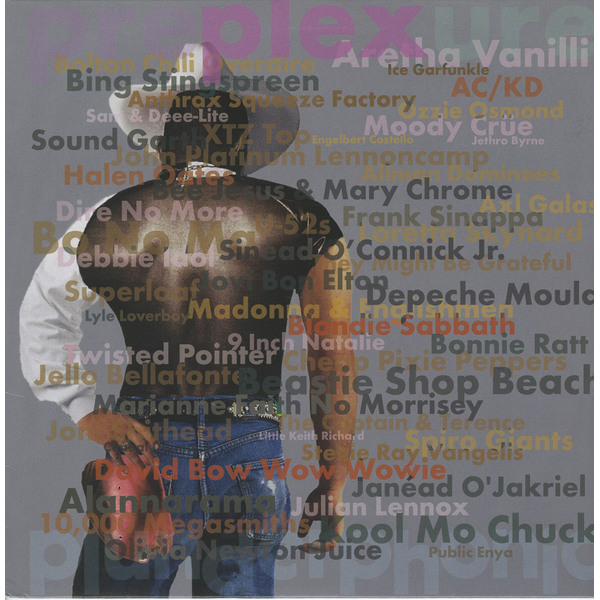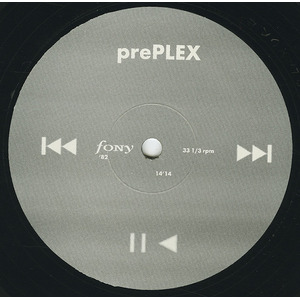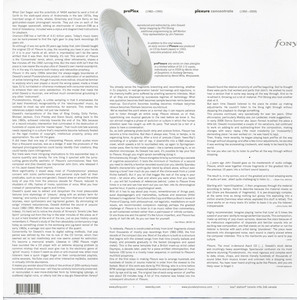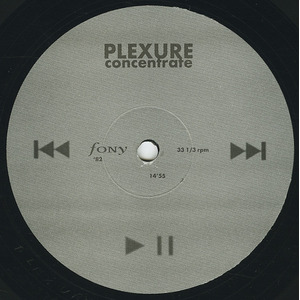Information/Write-up
"There was also a 2008 limited edition (16 copies) individually-cut 12-inch clear plexiglas version of this material with different art, published in Germany".
-John O.
Plexure is a composition Oswald created in 1992, commissioned by John Zorn for his Japan-based CD label Avant. The result was the 1993 release of an 18-minute mini-album of such remarkable complexity and density that everyone seems to remark on this (see below).
Plexure is constructed entirely from brief fragments cloned from thousands of mostly pop recordings from 1982-1992, the first decade of the compact disc era. Most of the album is built on a structure that begins with the slowest songs from that time (mostly ballads and blues), and proceeds gradually to the fastest (bluegrass and speed metal). This is the same structure that a British mash-up artist called Osymyso, a decade later, used for a piece entitled introinspection that features 100 tunes in a mostly linear sequence, in contrast to Plexure's multifold polyphony.
One of the first steps in making Plexure was to arrange hundreds and hundreds of tracks of source material in order from the slowest to the fastest. Most of this work was done by Phil Strong, who in a time before BPM catalogs existed, measured waveforms and arranged bars of music both by eye and by ear. The original bar-of-each-song version of prePlex was about 33 minutes long. A lot of this material was folded into the subsequent structure of Plexure.
Oswald found the relative simplicity of prePlex to be occasionally beguiling on its own. But he thought there were parts that worked and parts that didn't; he wished to hear a version that in a way swung all the way through. He did some editing, throwing out a lot of material, and Phil Strong also took another stab at it.
But each time Oswald listened to the piece he ended up making improvements. He couldn't listen to the thing right through without stopping the playback to change something.
This process continued, very sporadically for over ten years. At certain points others, particularly Wobbly aka Jon Leidecker, made suggestions.
In early 2006 Donna Summer aka Jason Forrest re-edited the piece. Oswald incorporated a couple of his variations, but continued to work on adding to and subtracting from the composition, still making changes every time he heard it ("the most insistently demanding piece i've ever worked on", he was heard to say).
Then, finally, recently he began playing back prePlex all the way through without stopping, for himself, and for others, and after a few minor adjustments, he decided it was working like accelerating clockwork, and ready to be heard by the world.
That's the version we're posting an excerpt of here. It's slightly different than the vinyl version on the vinyl and plexiglas releases.
Starting with ‘rapmillisylables’, it then progresses through the material according totempo. Hard to describe because the material moves so fast (there are thousandsof fragments). It is jaw-droppingly complex, at the same time as being nothing butglossy hits exploding into a million shards (harmless when whole, exploded this stuffis lethal). This piece works on so many levels it’s better to leave it to you the listener; indispensable. —Chris Cutler, ReR
Imagine playing ‘name that tune’ at 5 times the speed of yourears’ ability to recognize familiar sounds. This composition, made up entirely of popmusic samples, deserves five stars because of its meticulous organization of disparateand familiar sounds into an exciting new composition, one that stands on its ownwhether or not the listener is familiar with each artist being ‘plundered.’ The piece neverdescends into disorganized noise, each sound is clearly placed where the composerintended. This is the mailbomb you want to send to pop culture. —xmw
Plexure. The most in-demand Avant CD [...]. Oswald’s most dense and crushingly heavy assemblage. Spectacular confusion via his most extreme stunning Plunderphonic. His most rigorous and complex work to date, slices, chops, and blends literally hundreds of thousands of sound bites from musics known and unknown into a dizzying sonic whirlwind. You have never heard anything quite like Plexure, and you are likely never to forget it.
—forced exposure
Plexure is a composition Oswald created in 1992, commissioned by John Zorn for his Japan-based CD label Avant. The result was the 1993 release of an 18-minute mini-album of such remarkable complexity and density that everyone seems to remark on this (see below).
Plexure is constructed entirely from brief fragments cloned from thousands of mostly pop recordings from 1982-1992, the first decade of the compact disc era. Most of the album is built on a structure that begins with the slowest songs from that time (mostly ballads and blues), and proceeds gradually to the fastest (bluegrass and speed metal). This is the same structure that a British mash-up artist called Osymyso, a decade later, used for a piece entitled introinspection that features 100 tunes in a mostly linear sequence, in contrast to Plexure's multifold polyphony.
One of the first steps in making Plexure was to arrange hundreds and hundreds of tracks of source material in order from the slowest to the fastest. Most of this work was done by Phil Strong, who in a time before BPM catalogs existed, measured waveforms and arranged bars of music both by eye and by ear. The original bar-of-each-song version of prePlex was about 33 minutes long. A lot of this material was folded into the subsequent structure of Plexure.
Oswald found the relative simplicity of prePlex to be occasionally beguiling on its own. But he thought there were parts that worked and parts that didn't; he wished to hear a version that in a way swung all the way through. He did some editing, throwing out a lot of material, and Phil Strong also took another stab at it.
But each time Oswald listened to the piece he ended up making improvements. He couldn't listen to the thing right through without stopping the playback to change something.
This process continued, very sporadically for over ten years. At certain points others, particularly Wobbly aka Jon Leidecker, made suggestions.
In early 2006 Donna Summer aka Jason Forrest re-edited the piece. Oswald incorporated a couple of his variations, but continued to work on adding to and subtracting from the composition, still making changes every time he heard it ("the most insistently demanding piece i've ever worked on", he was heard to say).
Then, finally, recently he began playing back prePlex all the way through without stopping, for himself, and for others, and after a few minor adjustments, he decided it was working like accelerating clockwork, and ready to be heard by the world.
That's the version we're posting an excerpt of here. It's slightly different than the vinyl version on the vinyl and plexiglas releases.





No Comments